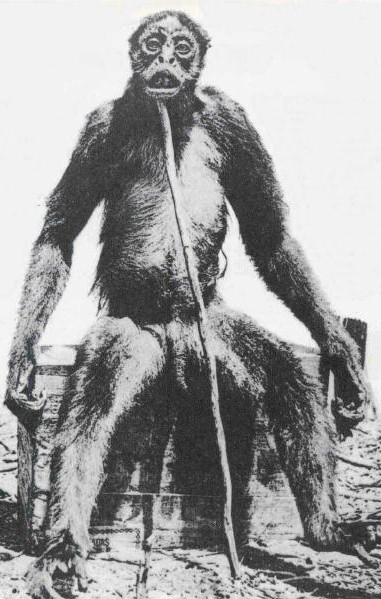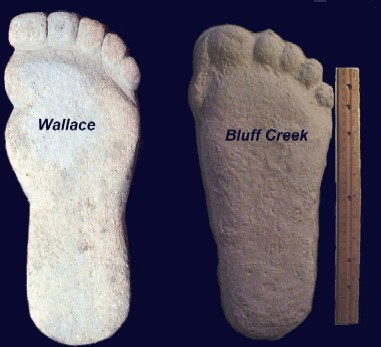Top Ten Reasons For Cryptozoology Hoaxes
Posted by: Loren Coleman on August 20th, 2008

The cropped photograph of the so-called Ameranthropoides loysi, de Loys’ alleged "ape," one of the most sinister hoaxes of all times (see #10 below).
In light of the Georgia Bigfoot Freezergate hoax (credit: Bobbie Short), I thought it might be a good idea to re-visit something I wrote in 2006. You will notice, in the examples below, there lurks in the shadows one that points to Tom Biscardi’s historical impact and another that details his old associate, Ivan Marx.
There are scores of motives for hoaxes. Here are a few that I think should float to the surface of any cesspool filled with this stuff.
My choices for the top ten major reasons that exist for hoaxing in cryptozoology are:
1.) Fiscal gain (e.g. allegedly the reason behind a hoaxster’s "Coast to Coast AM" radio appearances was so the guest’s broadcast claims of a "captured Bigfoot" video he said was going to post online would encourage "subscribers" to pay a fee to "see" it; the fact he did not deliver did not mean he ever gave the money back, allegedly; psychologically these individuals rarely admit guilt, but say they were “hoodwinked”);
2.) Fifteen minutes of fame (e.g. the late Ivan Marx, the late Ray Wallace, and other members of the alleged Bigfoot hoaxing fraternity appear to have had a psychological need for media-attention, mostly gained by allegedly producing false evidence);
3.) Pranks (i.e., these can be harmless teen, college or Halloween-style ones that go overboard and become local legends);
4.) Spreading misinformation (e.g. when I was doing research for Cryptozoology A to Z, an individual attempted to create an online history of sightings about the so-called "Ozark Howler," so I would write an entry on them in my forthcoming book; his deception was discovered and not one paragraph exists therein on that fake cryptid);
5.) Vandalism (i.e,. some hoaxing appears to be mischief, performed for psychological reasons only known to the creator, to cause disruptions for disruptions’ sake, in a display of misguided graps at power in a powerless or mentally unbalanced person; some have called these purely "evil" acts);
6.) Venting of anger or revenge targeting a specific group or individuals (i.e., a few manufactured events are private personalized incidents that may get incidental local or national media attention, although the original non-media motive may be lost in the publicity that results);
7.) Private exchanges gone bad (i.e., related to bragging, hoaxing, and pranks that spreads beyond a small circle of friends and foes, such as the faking of some Bigfoot prints in the Pacific Northwest by the late Ray Wallace and the late Rant Mullens may be partially laid to this motive, regarding their competitive membership in a "Liars Club")

8.) Misinterpreted jokes (e.g. these are funny gags that are misunderstood by others – botched – as discussing reality, discovered to be fiction, and thus have been labeled a hoax, perhaps inappropriately);
9.) Discrediting or promoting a company or an individual (i.e. these appear to be different than #6 above in that the public media factor is built into the hoax, on purpose; virtual marketing falls under this section); and
10.) Political reasons (e.g. the racism behind the photographs of spider monkeys taken by François De Loys in 1920 in Venezuela that have been passed off as unknown apes; the hoax was to support the eugenics theories of George Montandon, who was looking for an anthropoid precursor for the Native South Americans, just as he had said Africans evolved from gorillas and Asians from orangutans*; his theories were linked to the same ideas that the Nazis used against the Jewish, Roma people and other populations during the Holocaust).
De Loys’ "ape" is nothing more than a spider monkey, similar to the one pictured above, which you may enlarge by clicking on the image.
* "De Loys’s Photograph: A Short Tale of Apes in Green Hell, Spider Monkeys, and Ameranthropoides loysi as Tools of Racism" by Loren Coleman and Michel Raynal, in The Anomalist 4, Autumn 1996.
"Loren’s Top 10 Reasons For Cryptozoology Hoaxes" © Loren Coleman 2006.
About Loren Coleman
Loren Coleman is one of the world’s leading cryptozoologists, some say “the” leading living cryptozoologist. Certainly, he is acknowledged as the current living American researcher and writer who has most popularized cryptozoology in the late 20th and early 21st centuries.
Starting his fieldwork and investigations in 1960, after traveling and trekking extensively in pursuit of cryptozoological mysteries, Coleman began writing to share his experiences in 1969. An honorary member of Ivan T. Sanderson’s Society for the Investigation of the Unexplained in the 1970s, Coleman has been bestowed with similar honorary memberships of the North Idaho College Cryptozoology Club in 1983, and in subsequent years, that of the British Columbia Scientific Cryptozoology Club, CryptoSafari International, and other international organizations. He was also a Life Member and Benefactor of the International Society of Cryptozoology (now-defunct).
Loren Coleman’s daily blog, as a member of the Cryptomundo Team, served as an ongoing avenue of communication for the ever-growing body of cryptozoo news from 2005 through 2013. He returned as an infrequent contributor beginning Halloween week of 2015.
Coleman is the founder in 2003, and current director of the International Cryptozoology Museum in Portland, Maine.











ANYTHING regarding Bigfoot will always be a hoax.
Whether it’s ridiculous looking plaster casts, phenomenally grainy photographs, or tricksters claiming to have captured Bigfoot.
Think of how absurd the notion of an 8 foot apelike creature eluding photographers in the US over the past 100 is. Especially now when everyone carries a camera around with them(cellphone). There are 8 foot tall creatures in the US but they’re called bears and their skeletons are in museums, there are TONS of photographs of them, there are taxidermist versions, not to mention real live versions in zoos!
Perhaps being with the police force gives one a surprising amount of psychologycal stress. If a normal guy can suddenly snap and cut off a person’s head, I’m not surprised someone injured and under the stress of fighting criminals on a daily basis might snap in a much less murderous way. BTW, I’ve always thought there was something ironic about the name Bluff Creek…
It is absurd that a bigfoot creature has eluded photography, video, and forensic evidence in modern north america. The fact is these creatures have not eluded such evidence. It’s simply that whenever evidence is found: Patterson Gimlin/ photographs/ dermal ridges/ witness testimony, etc…it is categorically dismissed by the skeptical public. To reject all evidence and at the same time suggest there is no evidence is contradictory. There is plenty of evidence of their existence.
Its great to be able to log in here again, the first time in almost a week. I had to get my coverage of the “Georgia Event” from elsewhere 🙁
But in terms of this top 10 list, I think that sometimes “3” (harmless pranks) leads unintentionally to “2” (15 minutes fame) when a prank attracts much more attention than expected – and it becomes more difficult to admit it while maintaining any shred of credibility.
That probably was not a factor in this bigfoot-freezer case, but some suggest that happened in the case of the “Cottingley Fairy” photographs in the 1920’s…
I will go for Number 8.
You forgot reason #11: Real Estate Fraud, wherein a perpetrator tries to create a hoax monster (or cryptid) for the sole intention of devaluing property by scaring people away. Such properties in the past have been resorts/hotels, old mines and even failing amusement parks.
Luckily these plots are almost always foiled by a group of plucky teens and their loyal Great Dane.
😉
It never ceases to amaze me the people who say Bigfoot can’t exist because there are no good pictures of it. There are some extremely good photos not to mention plaster casts made by people who know what they are doing.
And as to the eluding people, a simple study of the geography of the US would show people how much of this country has not been explored on foot although aerial photos have been taken of almost all of it, at least where trees don’t block access to the ground. Other than hunters very, very few people ever go very far off marked trails, if they even do that. Even in a state as well populated as New Jersey is there is an area that probably has never been completely explored let alone photographed, this is The Pine Barrens. Once a person gets away from a city and away from highways it is amazing how much really rugged country there is in the United States. It is perfectly possible for a person to remain hidden for days, weeks, months and even longer in many of the states, even the well populated ones. If a person for which this is not natural to be able to do this, certainly a being for which the wilds are its native habit should be able to do it.
Don’t forget the Hollywood movie ending reason:
They sold the real body for ten million and “disappeared” to the south of France, covering their tracks with the hoax.
Aren’t we forgetting just plain good ol’ STUPIDITY?
I think this particular case and its pathetic demise was a weird mix of reasons. There was an initial desire to get attention along wit the juvenile prank attitude. But once they were getting attention of serious Crypto sites (i.e. Cryptomundo) they decided to raise that stakes. After that it becames blurrier, spcially when Biscardi became involved. I almost feel this guy gave the 50k to these bozos so they could disappear, but somewhat Mr. Kulls spoiled the plan with his integrity.
How much money did Biscardi win by charging for the privilege to see the photos on his site?
PS: And the weirdest thing about all this, is that now I’m finding myself wanting one of those “Bigfoottracker.com” T-shirts, just for the memorabilia factor 😉
PPS: Great to see this site up & running again!
You missed out ‘Carnival Hucksters’, Loren.
The Minnesota Iceman was one of the best hoaxes.
I don’t know, I still think the “Loys’ Ape” photo may not be, exactly, a spider monkey (at least, not a typical one.) The photographer captured something, and Loys’ used the photo as he saw fit, but that doesn’t necessarily mean the photo itself was a hoax. I see some morphological differences between that photo, and photos of known spider monkeys. Maybe it was a different kind of spider monkey? Or, if it was bipedal, it could have been something else. I think, too often, people discount possibilities until the discounted possibilities turn out to be realities, that land on one’s head. 🙂 For instance, there is at least some evidence, that hominoid evolution did occur in the Americas. Recall the many insistent claims that “experts” have made, that have later turned out to be false. (Such as, sabre tooth cats never made it to South America.) If Native American lore, and certain archaeological pieces of evidence, are to be considered and not just discarded out of hand, it appears that hominids/hominoids may well have been in the Americas for millions of years. There’s even a controversial site near Puebla, Mexico, that they’ve reportedly started digging at, again… that bears evidence of really, really old hominid tools and habitation. I’m not saying the primate in the photo is any particular kind of primate, I’m just saying, perhaps we can’t be too sure, at this point. Alleged political motives of one person involved, doesn’t necessarily define what, exactly, was the subject of the actual photo.
I think hoaxes are dishonest and noone should do them
On the other hand, there is always a market for books, television documentaries and websites on “Hoaxes & Swindles”.
So no matter how implausible or unlikely the hoaxed “event” may seem, once it get enough attention in the media/public, it will be a contender for coverage and attention for many years after the fact.
To some extent it seems to be the need that some individuals seem to have, for leaving a legacy of any kind, regardless of how dubious an honour the chosen method may seem.
That way they get much more than their 15 minutes of fame.
There is another type of hoax that isn’t often mentioned by advocates: I call it the Anxious Believer Hoax. This hoax is perpetrated by advocates of particular anomalies in order to advance belief. The hoaxer just “knows” that a particular anomaly or cryptid is “real” and becomes impatient when definitive evidence does not materialize. Since the hoaxer believes the cryptid exists (or ghosts, UFOs, etc. exists), he or she helps it along by creating a hoax that “verifies” it’s existence. Also, this feeds into the fantasy that the hoaxer has done something very important, even earth shaking: he or she has “proven” the “existence” of a cryptid (already “known” to exist in the hoaxer’s mind).
I would put Patterson in this class of hoaxers, although we should not rule out a monetary motive here as well. I would not put Dinsdale in this category. He proved trustworthy enough for us to accept his accounting of his Nessie film (which is not to say that he filmed Nessie, but only that his film is not a hoax).
There is a certain sort of person who perpetrates a hoax of a cryptozoological nature that I have come across in this country (Australia) and they are usually characterised by a particularly mean spirited disposition. They tend to be incensed that private individuals are going to some effort to investigate, at their own trouble and expense, something that might upset the hoaxers own personal universe (hicks v. geeks?) They can only respond by trying to create a milleux whereby the investigator is made to look like a fool or clown for the public to ridicule. These hoaxers are classic flat earthers and book burners and they exist at all levels of society. They don’t have the wit to be healthy sceptics like any one of a genuine scientific disposition, and I include worthwhile cryptozoological researchers here. Hoaxers need to be put in their place and appropriately chastised. There is nothing commendable, ever, in hoaxing. We researchers just haven’t got the time.
I’m not sure I see this reason among the ones listed: demonstrating people’s ignorance.
A number of hoaxes – or allegations of same – seem to be for the purpose of showing up not only proponents but skeptics. Watch the “skeptical” reaction any time anyone even alleges he hoaxed something. Not so skeptical, is it? It’s even conceivable that Biscardi gets taken, again and again, by people who enjoy not only the attention but how easy it is to fool The Bigfoot Hunter.
Then again, the public’s ignorance sometimes has the co-ignorant laughing, all the way to the bank. Or at least the newspapers.